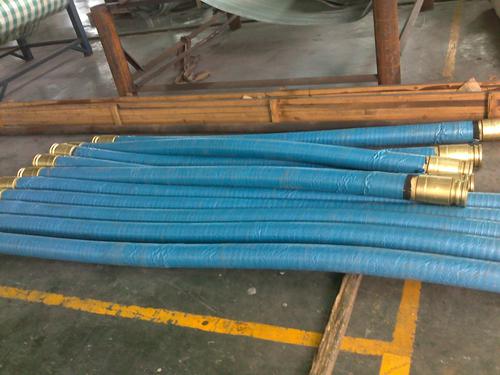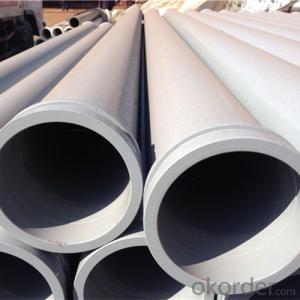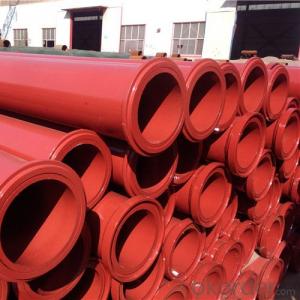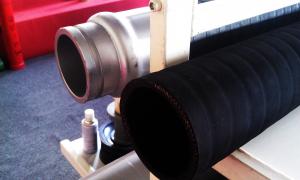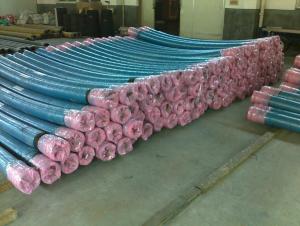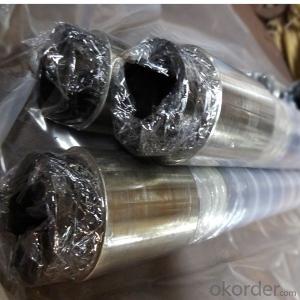Concrete Pump Rubber End Hose DN64
- Loading Port:
- China Main Port
- Payment Terms:
- TT OR LC
- Min Order Qty:
- -
- Supply Capability:
- -
OKorder Service Pledge
OKorder Financial Service
You Might Also Like

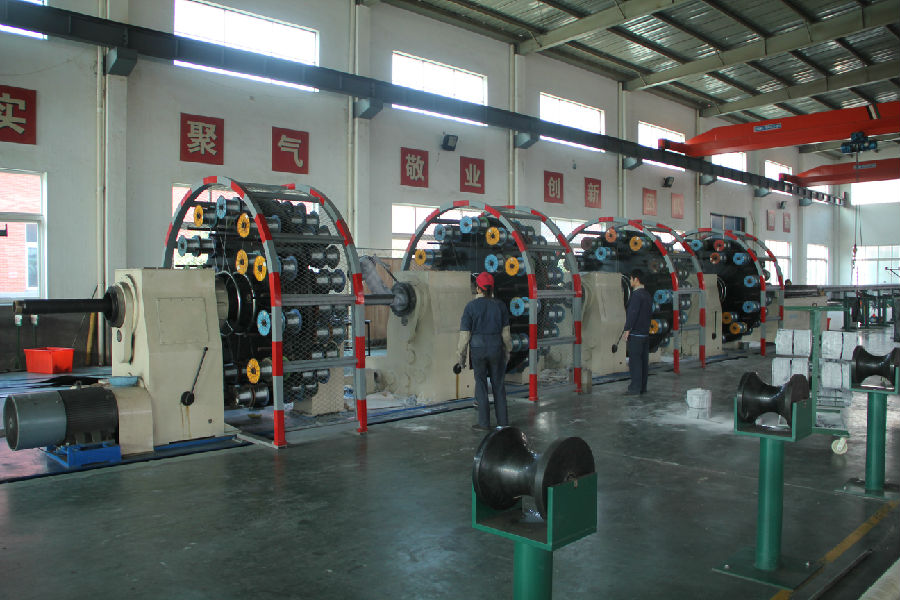
Specifications
Dn64 concrete pump rubber hose1.Size:2.5 inch
2.Steel hose
3.2 or 4 piles of steel wires for your choose.
DN64 CONCRETE PUMP RUBBER HOSE
1.Work Pressure:85~1250(BAR/PSI)
2.Burst Pressure:200 to 2940(BAR/PSI)
3.Working life:20000m³
4.The inside of hose is high abrasion resistant.
5.Integrated hose end and inner wall harden,prolong work life.
Relevant Information:
Name | Concrete rubber hose; Delivery hose; End hose; Concrete pump hose; Boom hose |
Size | 2"/2.5"/3"/3.5"/4"/4.5"/5"/6"or according to client’s requirement |
Length | 3M,5 or Any length |
Reinforcement | Steel wire, tire cord or fabric |
Hose End | Galvanized, inner wall harden |
Application | Schwing, Putzmeister, Sany, Zoomlion, etc |
- Q: Are there any specific training or certifications required for handling and installing concrete pump spare parts?
- Yes, specific training and certifications are required for handling and installing concrete pump spare parts. Individuals working in this field usually undergo specialized training programs to gain a comprehensive understanding of the equipment, safety protocols, and proper installation techniques. Additionally, some manufacturers or organizations may offer certifications to ensure that professionals have met certain industry standards and possess the necessary skills to handle and install concrete pump spare parts effectively and safely.
- Q: How often should concrete pump pistons be inspected and replaced?
- Concrete pump pistons should be inspected regularly, ideally after every 200 to 300 hours of operation or at least once every three months. The frequency of replacement will depend on various factors such as the quality of materials being pumped, the pumping conditions, and the maintenance practices followed. However, as a general guideline, pistons should be replaced when signs of wear and tear, such as cracks, excessive leakage, or loss of pumping efficiency, become noticeable during inspections.
- Q: How can you determine when a concrete pump hose needs to be replaced?
- There are a few signs that can indicate when a concrete pump hose needs to be replaced. Firstly, if there are any visible cracks or tears on the hose, it is a definite indication that it needs to be replaced. Additionally, if you notice any leaks or excessive wear and tear on the hose, it may be time for a replacement. Regular inspections and maintenance can help identify any signs of damage or deterioration, ensuring the safety and efficiency of the concrete pump.
- Q: How to operate the concrete pump?
- All the bolts of the pumping unit shall be fastened, and the pipe joints shall be tightly sealed. The protective devices shall be complete and reliable
- Q: What is the farthest pumping distance of concrete pump truck?
- Concrete pump, commonly known as to pump, or supporting pump, pumping height is determined by the power of the engine, 08 years in Guangzhou pearl, vanda heavy section pump made of C100 high strength concrete vertical height of 411 meters world record, the engine for the 572KW
- Q: Can I get spare parts for concrete pump hopper agitators and vibrators?
- Yes, spare parts for concrete pump hopper agitators and vibrators are generally available. These parts can be sourced from various manufacturers and suppliers specializing in construction equipment and machinery. It is recommended to contact the manufacturer of the concrete pump or the authorized dealer to inquire about the availability and pricing of spare parts for the hopper agitators and vibrators. Additionally, there are also online platforms and marketplaces that offer a wide range of spare parts for construction equipment, including concrete pump components. It is important to provide specific details about the make and model of the concrete pump to ensure compatibility and proper functioning of the spare parts.
- Q: What are the signs of a malfunctioning concrete pump outrigger?
- There are multiple indicators that point towards a malfunctioning concrete pump outrigger. 1. An uneven or unstable platform may suggest that the outrigger is not functioning properly. This can be observed when the pump is not level or when the platform exhibits excessive movement or shaking. 2. The presence of hydraulic fluid leaks in the outrigger's hydraulic system is a telltale sign of malfunction. If you notice puddles or stains on the ground caused by hydraulic fluid, it signifies a problem. 3. If the outrigger is slow to extend or retract, or if it does not respond to the controls, it indicates a malfunction. This can jeopardize the stability of the pump and should be taken seriously. 4. Unusual noises emanating from the outrigger, such as grinding, whining, or knocking sounds, can be indicative of mechanical issues or loose components. Ignoring these noises may lead to underlying problems that require attention. 5. It is crucial to visually inspect the outrigger for any visible damage, such as bent or cracked components, loose bolts, or missing parts. These physical signs of damage can impair the functionality and stability of the outrigger. Regular inspection and maintenance of the concrete pump outrigger are essential for ensuring safe and efficient operation. If any of these signs are present, it is advisable to cease using the pump and have it inspected and repaired by a qualified professional to prevent further damage or accidents.
- Q: How can one identify the need for replacement of concrete pump spare parts?
- One can identify the need for replacement of concrete pump spare parts by observing certain signs and conducting regular maintenance checks. Firstly, it is important to monitor the performance of the concrete pump. If there is a decrease in efficiency or a significant drop in the output of the pump, it could indicate the need for replacement parts. This could be due to worn-out components that are affecting the pump's ability to deliver concrete effectively. Another sign to look for is abnormal noise coming from the pump. Unusual or excessive noise can indicate problems with the moving parts, such as bearings or seals, which may need to be replaced. Inspecting the wear and tear of the spare parts is also crucial. Components such as hoses, pipes, and seals can deteriorate over time due to the abrasive nature of concrete. If there are visible signs of wear, such as cracks, leaks, or bulges, it is likely that these parts need to be replaced. Regular maintenance checks are essential in identifying the need for replacement parts. This can involve checking the condition of key components, such as the piston, cylinder, and valves, and ensuring they are clean, properly lubricated, and functioning correctly. Any signs of damage, corrosion, or excessive wear should be addressed promptly to prevent further damage to the pump and the need for more extensive repairs. In summary, by closely monitoring the performance of the concrete pump, listening for abnormal noise, inspecting for wear and tear, and conducting regular maintenance checks, one can effectively identify the need for replacement of concrete pump spare parts. Timely replacement of these parts can help maintain the pump's efficiency and prolong its lifespan.
- Q: How often should concrete pump S valves be inspected and replaced?
- Concrete pump S valves should be inspected regularly, ideally every 500 hours of operation or at least once a year. However, the replacement of S valves will depend on various factors such as the quality of the concrete being pumped, the frequency of use, and the overall condition of the valve. It is recommended to consult the manufacturer's guidelines and seek professional advice to determine the specific timing of S valve replacement.
- Q: How does a concrete pump clamp work?
- A concrete pump clamp is an essential component of a concrete pump that is used to secure and hold the concrete delivery pipeline in place. It works by tightly gripping the pipeline to prevent any movement or leaks during the concrete pumping process. Typically, a concrete pump clamp consists of two main parts: the clamp body and the wedge. The clamp body is usually made of durable steel and has a curved shape that is designed to fit around the pipeline. It is equipped with bolts or knobs that can be tightened or loosened to secure the clamp onto the pipeline. The wedge, on the other hand, is a piece of metal that is inserted into the clamp body. It is responsible for exerting pressure onto the pipeline when the clamp is tightened. By turning the bolts or knobs, the wedge is pushed further into the clamp body, causing it to squeeze the pipeline tightly and create a firm grip. The tight grip created by the concrete pump clamp is crucial as it ensures that there are no leaks or disruptions in the concrete flow. It helps to maintain a consistent and steady flow of concrete from the pump to the desired location. Additionally, the clamp also provides stability to the pipeline, preventing it from moving or shifting during the pumping process. Overall, a concrete pump clamp plays a vital role in the efficient and safe operation of a concrete pump. It ensures that the concrete delivery pipeline remains securely in place, allowing for a smooth and uninterrupted concrete pumping process.
Send your message to us
Concrete Pump Rubber End Hose DN64
- Loading Port:
- China Main Port
- Payment Terms:
- TT OR LC
- Min Order Qty:
- -
- Supply Capability:
- -
OKorder Service Pledge
OKorder Financial Service
Similar products
Hot products
Hot Searches
Related keywords


